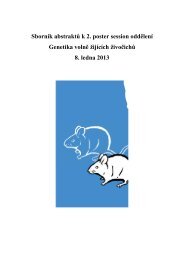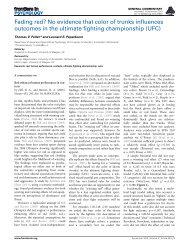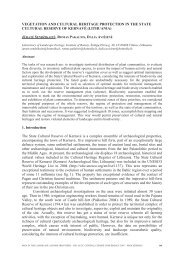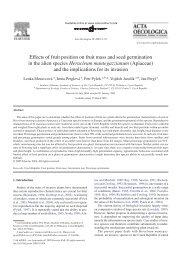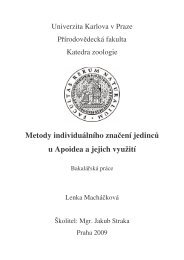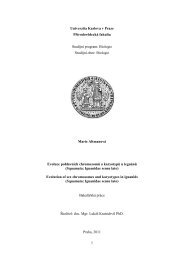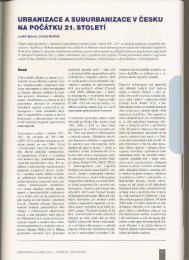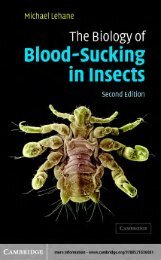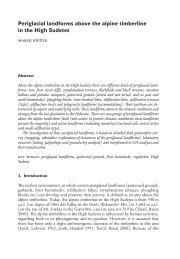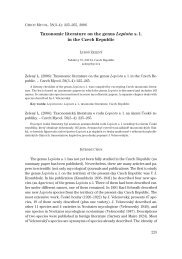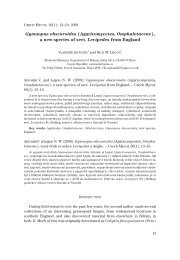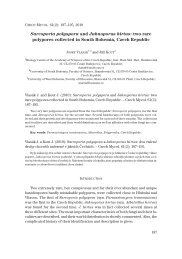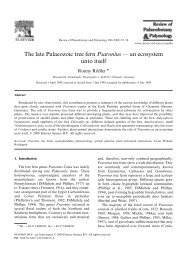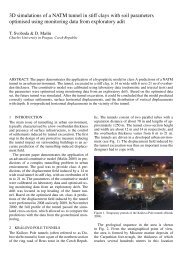Egg shape and size allometry in geckos (Squamata: Gekkota ...
Egg shape and size allometry in geckos (Squamata: Gekkota ...
Egg shape and size allometry in geckos (Squamata: Gekkota ...
You also want an ePaper? Increase the reach of your titles
YUMPU automatically turns print PDFs into web optimized ePapers that Google loves.
Ó 2005 Blackwell Verlag, Berl<strong>in</strong> Accepted on 23 September 2005<br />
JZS doi: 10.1111/j.1439-0469.2005.00339.x<br />
Faculty of Science, Charles University <strong>in</strong> Prague, Departments of 1 Ecology <strong>and</strong> 2 Zoology, V<strong>in</strong>icˇna´ 7, Praha 2, Czech Republic<br />
<strong>Egg</strong> <strong>shape</strong> <strong>and</strong> <strong>size</strong> <strong>allometry</strong> <strong>in</strong> <strong>geckos</strong> (<strong>Squamata</strong>: <strong>Gekkota</strong>), lizards with<br />
contrast<strong>in</strong>g eggshell structure: why lay spherical eggs?<br />
L. Kratochvíl 1 <strong>and</strong> D. Frynta 2<br />
Abstract<br />
Hard, highly calcified eggshells evolved several <strong>in</strong>dependent times dur<strong>in</strong>g the history of amniotes. Because of phylogenetic conservatism of this<br />
trait, l<strong>in</strong>eages <strong>in</strong> which closely related taxa differ <strong>in</strong> eggshell structure are rare. Four gekkotan families (Carphodactylidae, Diplodactylidae,<br />
Eublepharidae <strong>and</strong> Pygopodidae) have eggs with soft shells, while their close relatives (Gekkonidae) lay eggs with hard shells. Geckos thus<br />
offer a rare opportunity to compare the impact of the emergence of a hard eggshell on the economy of egg architecture. Because a sphere has<br />
the smallest surface area of all three-dimensional solids of a given volume, spherical eggs <strong>in</strong> <strong>geckos</strong> with hard eggshells reduce calcium<br />
<strong>in</strong>vestment <strong>and</strong> should therefore be advantageous. Here, we document that hard-shelled gekkonid eggs are <strong>in</strong>deed more spherical than those of<br />
the other gecko l<strong>in</strong>eages. However, with<strong>in</strong> gekkonids, small species lay more elongated eggs than larger species. We speculate that m<strong>in</strong>iature<br />
gekkonid females, which lay larger eggs relative to body <strong>size</strong> compared with large gekkonids, produce elongate eggs <strong>in</strong> order to pass the egg<br />
through a limited pelvic open<strong>in</strong>g.<br />
Key words: constra<strong>in</strong>t – cost of reproduction – egg <strong>size</strong> <strong>allometry</strong> – life history – lizard – reproductive effort<br />
Introduction<br />
A hard, calcareous eggshell evolved <strong>in</strong>dependently <strong>in</strong> different<br />
l<strong>in</strong>eages of amniote vertebrates (turtles, <strong>geckos</strong>, crocodiles <strong>and</strong><br />
birds; Pough et al. 1998). The occurrence of a hard eggshell<br />
dur<strong>in</strong>g the history of these l<strong>in</strong>eages was a key evolutionary<br />
novelty with a large impact on the reproductive physiology<br />
<strong>and</strong> life history of the animals <strong>in</strong>volved. The emergence of hard<br />
shells occurred early <strong>in</strong> amniote history. As a result, we cannot<br />
make direct observations when <strong>in</strong>vestigat<strong>in</strong>g the consequences<br />
of the presence of hard eggshells. We are therefore restricted to<br />
comparative studies between the hard-shelled l<strong>in</strong>eages <strong>and</strong><br />
their relatives with soft shells. Unfortunately, <strong>in</strong> most cases we<br />
do not know the closest liv<strong>in</strong>g relatives with a contrast<strong>in</strong>g state<br />
of eggshell softness or these relatives differ radically <strong>in</strong> body<br />
<strong>shape</strong> <strong>and</strong> way of life.<br />
In squamate reptiles, the generally flexible <strong>and</strong> poorly<br />
m<strong>in</strong>eralized parchment-like eggshell is clearly ancestral, with<br />
hard shells occurr<strong>in</strong>g only <strong>in</strong> the gecko family Gekkonidae<br />
(Andrews 2004). Close relatives of Gekkonidae, <strong>geckos</strong> of the<br />
families Carphodactylidae, Diplodactylidae, Pygopodidae <strong>and</strong><br />
Eublepharidae, have ancestral soft eggshells (with the sole<br />
exception of the diplodactylid genus Eurydactylodes Wermuth,<br />
1965; Russell <strong>and</strong> Bauer 2002). Geckos thus offer a rare<br />
opportunity to compare the impact of the emergence of a hard<br />
eggshell on the economy of egg architecture among closely<br />
related organisms. Throughout this paper, we follow the highorder<br />
classification of the liv<strong>in</strong>g <strong>Gekkota</strong> recently suggested by<br />
Han et al. (2004). However, we should note that this classification<br />
is not def<strong>in</strong>itive. Most authors agree that Eublepharidae<br />
are the sister group of all rema<strong>in</strong><strong>in</strong>g gekkotans <strong>and</strong> that<br />
Gekkonidae are a well-supported monophyletic group. However,<br />
while the mutual position <strong>and</strong> exclusive monophyly of<br />
Carphodactylidae, Diplodactylidae <strong>and</strong> Pygopodidae are still<br />
questionable, it is clear that these groups form monophyly with<br />
respect to Gekkonidae <strong>and</strong> Eublepharidae (cf. Kluge 1987;<br />
Donnellan et al. 1999; Han et al. 2004).<br />
Another advantage of <strong>geckos</strong> for comparative analysis of<br />
egg <strong>shape</strong> is that female <strong>geckos</strong> of all species lay <strong>in</strong>variant<br />
clutches of one or two eggs (Sh<strong>in</strong>e <strong>and</strong> Greer 1991). Consequently,<br />
gecko females have no more than one develop<strong>in</strong>g egg<br />
<strong>in</strong> a s<strong>in</strong>gle ovary at a time. The potential <strong>in</strong>fluence of the clutch<br />
<strong>size</strong> on egg <strong>shape</strong> (Elgar <strong>and</strong> Heaphy 1989) is therefore<br />
considerably m<strong>in</strong>imized.<br />
A hard eggshell undoubtedly offers a better protection<br />
aga<strong>in</strong>st <strong>in</strong>vertebrate predators <strong>and</strong> desiccat<strong>in</strong>g environmental<br />
conditions than a soft shell (Gardner 1985). For <strong>in</strong>stance,<br />
the eggs of many gekkonids can be successfully <strong>in</strong>cubated <strong>in</strong><br />
an almost dry environment (Ro¨ sler 2005; Kratochvı´ l,<br />
personal observation). On the contrary, the highly m<strong>in</strong>eralized<br />
hard eggshell is much more costly to produce, as<br />
calcium is a limited element for most terrestrial organisms.<br />
In fact, a decrease <strong>in</strong> bone compactness <strong>in</strong> reproductive<br />
females due to deposition of skeletal calcium <strong>in</strong>to eggs or<br />
offspr<strong>in</strong>g has been reported <strong>in</strong> birds, turtles <strong>and</strong> crocodiles<br />
(groups with heavily calcified eggshells), but also <strong>in</strong> a<br />
viviparous snake <strong>and</strong> a lizard species with poorly m<strong>in</strong>eralized<br />
eggshell (de Buffre´ nil <strong>and</strong> Francillon-Vieillot 2001, <strong>and</strong><br />
references there<strong>in</strong>).<br />
A more spherical hard-shelled egg would m<strong>in</strong>imize the<br />
consumption of calcium, because a sphere has the least<br />
surface area of all solids of a given volume. In the present<br />
study, we use <strong>in</strong>terspecific comparative methods to test the<br />
hypothesis that <strong>geckos</strong> produc<strong>in</strong>g hard-shelled eggs have<br />
more spherical eggs than <strong>geckos</strong> with soft eggs. Indeed,<br />
anecdotal evidence suggests that the gekkotan families differ<br />
<strong>in</strong> egg <strong>shape</strong>: carphodactylids, diplodactylids <strong>and</strong> eublepharids<br />
produce elongated eggs, whereas gekkonids have much<br />
more spherical eggs (Doughty 1997). Here, we perform the<br />
first direct comparison of egg <strong>shape</strong> <strong>in</strong> <strong>geckos</strong> at the family<br />
level <strong>and</strong> quantify the egg <strong>shape</strong> <strong>allometry</strong> of different gecko<br />
groups. The perfectly spherical egg would be the most<br />
economical from the perspective of calcium consumption;<br />
however, we found that most (but not all) hard-shelled<br />
gecko eggs are somewhat elongated. Are these deviations<br />
from ideal <strong>shape</strong> r<strong>and</strong>om, or does the <strong>shape</strong> variation relate<br />
to variations <strong>in</strong> <strong>size</strong>?<br />
JZS (2006) 44(3), 217–222
218 KratochvÍl <strong>and</strong> Frynta<br />
Materials <strong>and</strong> Methods<br />
Data on egg <strong>size</strong> <strong>and</strong> <strong>shape</strong><br />
Data were collected from taxonomic works <strong>and</strong> field guides<br />
(Loveridge 1947; Szczerbak <strong>and</strong> Golubev 1986; Manthey <strong>and</strong><br />
Grossmann 1997; Branch 1998; Greer 2003) <strong>and</strong> from herpetological<br />
<strong>and</strong> herpetocultural books <strong>and</strong> journals (Easterla <strong>and</strong> Reynolds<br />
1975; Gallo <strong>and</strong> Reese 1978; Mudrack 1985a,b; Vitt 1986; Ulber<br />
<strong>and</strong> Ulber 1987; Grossmann <strong>and</strong> Ste<strong>in</strong> 1988; Henkel 1988; Ste<strong>in</strong><br />
1988; Grossmann <strong>and</strong> Ulber 1990; Leptien <strong>and</strong> Zilger 1991; Schäfer<br />
1991, 1993; Seufer 1991; Kovárˇ 1992; Havelka 1993a,b, 1994;<br />
Leptien et al. 1994; Rickert 1994; Hulbert 1995; Rickert 1995;<br />
Doughty 1996, 1997; Röll 1996, 1998, 1999, 2000a,b, 2003; Laube<br />
1997, 2001, 2002; Leptien <strong>and</strong> Lui 1997; Vitt <strong>and</strong> Zani 1997; Laube<br />
<strong>and</strong> Seipp 1998, 1999; Trautmann 1998; Leptien 1999; Pietchmann<br />
<strong>and</strong> Klusmeyer 1999; König 2000; Schröder <strong>and</strong> Ro¨ ll 2000, 2002,<br />
2003; Seipp <strong>and</strong> Henkel 2000; Barts et al. 2001; Vergner 2001;<br />
Anders 2002; Barts 2002a,b; Poulícˇ ek 2002; Funk 2003; Funk <strong>and</strong><br />
Vrabec 2004; Vences et al. 2004; Ro¨ sler 2005), as well as from our<br />
own observations (especially our analysis of 358 clutches of<br />
eublepharid <strong>geckos</strong>; Kratochvíl <strong>and</strong> Frynta 2006). The complete<br />
dataset is available upon request to the correspond<strong>in</strong>g author. As<br />
eggs with leathery eggshells <strong>in</strong>crease their volume dur<strong>in</strong>g <strong>in</strong>cubation,<br />
only data of freshly laid eggs were <strong>in</strong>cluded for groups with soft<br />
eggs. The EMBL database (Uetz 2005) was used to identify<br />
synonymous names among those used <strong>in</strong> the literature. For every<br />
taxon, we took a mean of values when more than one source was<br />
available for a given taxon. Otherwise, we took a midpo<strong>in</strong>t of<br />
published ranges. Altogether we compiled data for 308 taxa of<br />
<strong>geckos</strong> (13 species of eublepharids, 34 species of diplodactylids, 14<br />
species of carphodactylids, 13 species of pygopodids <strong>and</strong> 234 species<br />
<strong>and</strong>/or subspecies of gekkonids).<br />
Scal<strong>in</strong>g relations<br />
To test the hypothesis on the scal<strong>in</strong>g of egg length (l) on egg width (w)<br />
we applied the power function l ¼ aw b (Huxley 1932) <strong>in</strong> its<br />
log 10 -transformed form:<br />
log 10 l ¼ log 10 a þ b log 10 w:<br />
When consider<strong>in</strong>g isometric relationship, the expected slope (b) is 1.0<br />
as both l <strong>and</strong> w are of l<strong>in</strong>ear dimension. For the regression slope<br />
estimations, we employed the reduced major axis regression (RMA)<br />
model because it accounts for an error <strong>in</strong> the Ô<strong>in</strong>dependentÕ variable<br />
(McArdle 1988). RMA regression coefficients were computed us<strong>in</strong>g<br />
RMA version 1.14b programme (Bohonak 2002). To explore whether<br />
egg <strong>shape</strong> changes with <strong>size</strong>, we also used an alternative method. We<br />
computed the egg <strong>shape</strong> parameter as the ratio of egg length to egg<br />
width <strong>and</strong> searched for an <strong>in</strong>terspecific correlation between the<br />
computed variable <strong>and</strong> egg width.<br />
The <strong>in</strong>vestigation based on comparative analysis of <strong>in</strong>terspecific<br />
data requires a phylogenetic framework. The approach employed <strong>in</strong><br />
this study is the calculation of st<strong>and</strong>ardized <strong>in</strong>dependent contrasts<br />
(Felsenste<strong>in</strong> 1985). As a control for the phylogenetic relationship <strong>and</strong><br />
the calculation of <strong>in</strong>dependent contrasts <strong>in</strong> eublepharids <strong>and</strong> pygopodids,<br />
we used fully resolved phylogenetic hypotheses proposed by<br />
Kratochvı´ l <strong>and</strong> Frynta (2002) <strong>and</strong> Jenn<strong>in</strong>gs et al. (2003) respectively.<br />
Currently, there is no available, fully resolved phylogeny for all<br />
carphodactylids, diplodactylids <strong>and</strong> gekkonids. Therefore, we used a<br />
method for phylogenetic analysis of comparative data when the<br />
phylogeny is only partly known (Housworth <strong>and</strong> Mart<strong>in</strong>s 2001).<br />
Us<strong>in</strong>g mesquite version 1.02 software (Maddison <strong>and</strong> Maddison<br />
2004), we generated mostly unresolved phylogenies separately for<br />
carphodactylids + diplodactylids <strong>and</strong> gekkonids, with the constra<strong>in</strong>t<br />
that the species grouped <strong>in</strong> one genus <strong>and</strong> subspecies of one species<br />
should always go together <strong>in</strong> a clade. Moreover, as an additional<br />
constra<strong>in</strong>t for carphodactylids + diplodactylids we used Greer’s<br />
(1989) cladogram of carphodactylid <strong>and</strong> diplodactylid genera supplemented<br />
with recently proposed phylogenies for the genera<br />
Diplodactylus Gray, 1832 (Melville et al. 2004), Phyllurus Sch<strong>in</strong>z,<br />
1817 <strong>and</strong> Saltuarius Couper, Covacevich et Moritz, 1993 (Hosk<strong>in</strong><br />
et al. 2003) <strong>and</strong> Rhacodactylus Fitz<strong>in</strong>ger, 1843 (Good et al. 1997).<br />
For gekkonids, we grouped together several genera generally recognized<br />
as related (Phyllodactylus Gray, 1828 – Paroedura Gu¨ nther,<br />
1879 – Asaccus Dixon et Anderson, 1973 – Christ<strong>in</strong>us Wells et<br />
Well<strong>in</strong>gton, 1983 – Dixonius Boulenger, 1898 – Afrogecko Daud<strong>in</strong>,<br />
1802 – Goggia Gray, 1838 – Euleptes Fitz<strong>in</strong>ger, 1843; Gymnodactylus<br />
Spix, 1825 – Cyrtodactylus Gray, 1827 – Cyrtopodion Fitz<strong>in</strong>ger, 1843<br />
– Bunopus Blanford, 1874; Pachydactylus Wiegmann, 1834 – Tarentola<br />
Gray, 1825 <strong>in</strong>clud<strong>in</strong>g Geckonia Mocquard, 1895 – Rhoptropus<br />
Peters, 1869 – Chondrodactylus Peters, 1870 – Palmatogecko Andersson,<br />
1908; Gekko Laurenti, 1768 – Gehyra Gray, 1834 – Hemiphyllodactylus<br />
Bleeker, 1860 – Lepidodactylus Fitz<strong>in</strong>ger, 1843 –<br />
Pseudogekko Taylor, 1922 – Ptychozoon Kuhl et van Hasselt, 1822;<br />
Hemidactylus Gray, 1825 – Cosymbotus Fitz<strong>in</strong>ger, 1843 – Teratolepis<br />
Gu¨ nther, 1870; Lygodactylus Gray, 1864 – Phelsuma Gray, 1825;<br />
Russell <strong>and</strong> Bauer 2002). With<strong>in</strong> the genera Phelsuma <strong>and</strong> Tarentola<br />
(<strong>in</strong>clud<strong>in</strong>g Geckonia) we used phylogenetic hypotheses published by<br />
Carranza et al. (2002) <strong>and</strong> Aust<strong>in</strong> et al. (2004). After the derivations<br />
of constra<strong>in</strong>ed trees, we tested the robustness of a scal<strong>in</strong>g relationship<br />
to phylogenetic effects us<strong>in</strong>g an analysis by <strong>in</strong>dependent contrasts for<br />
each Ôphylogeny.Õ The regression slopes were calculated us<strong>in</strong>g pdap:<br />
pdtreepackage for mesquite version 1.00 (Midford et al. 2002). In<br />
phylogenetic analyses we set all branches to the same lengths, because<br />
estimations of branch lengths are available neither for eublepharids<br />
nor for groups with partially unknown phylogeny. Thus <strong>in</strong> contrasts<br />
analyses we assumed a punctuational model of evolution. All<br />
regression analyses based on <strong>in</strong>dependent contrasts scores were<br />
constra<strong>in</strong>ed to pass through the orig<strong>in</strong>.<br />
Estimation of calcium sav<strong>in</strong>g of spherical versus elliptical eggs<br />
Actual calcium deposition <strong>in</strong>to eggshells must be specified empirically.<br />
However, to roughly estimate the sav<strong>in</strong>g of calcium ow<strong>in</strong>g to egg<br />
round<strong>in</strong>g (neglect<strong>in</strong>g the differences <strong>in</strong> eggshell thickness <strong>and</strong> m<strong>in</strong>eral<br />
density), we compared the approximated surface of a gekkotan egg<br />
with the surface of a sphere of the same volume. We calculated egg<br />
volume (V) <strong>and</strong> egg surface (S) from the formulae for a prolate<br />
spheroid: V ¼ (4p/3)ab 2 , S ¼ 2pb(b + a arcs<strong>in</strong>[e]/e), where a ¼ (egg<br />
length)/2, b ¼ (egg width)/2, e ¼ (a 2 ) b 2 ) 1/2 /a. Next, we calculated<br />
surface of a sphere with the same volume as an <strong>in</strong>dividual speciesÕ egg:<br />
S ¢ ¼ 4pr 2 , where r ¼ (3 V/4p) 1/3 . We took s ¼ (S/S ¢ ) 1) · 100 as an<br />
estimation of a potential sav<strong>in</strong>g of calcium that could be implemented<br />
by mak<strong>in</strong>g ideally spherical eggs, <strong>and</strong> compared s values between <strong>and</strong><br />
with<strong>in</strong> groups.<br />
Results<br />
As expected, <strong>geckos</strong> exhibit extensive <strong>in</strong>terspecific variation <strong>in</strong><br />
egg <strong>size</strong> <strong>and</strong> <strong>shape</strong> (Fig. 1). As Carphodactylidae <strong>and</strong> Diplodactylidae<br />
differ neither <strong>in</strong> slope nor <strong>in</strong> <strong>in</strong>tercept of the<br />
regression l<strong>in</strong>e of egg length on egg width (GLM ancova, both<br />
p > 0.28), we comb<strong>in</strong>ed data for both these group <strong>in</strong> all<br />
subsequent analyses. Allometric slopes for eublepharid (95%<br />
CI of the slope ¼ 0.981 ± 0.175, r ¼ 0.96), carphodactylid<br />
<strong>and</strong> diplodactylid <strong>geckos</strong> (CI ¼ 0.986 ± 0.086, r ¼ 0.96)<br />
computed by RMA regression are very close to an isometric<br />
slope <strong>and</strong> they do not statistically differ from 1.0. The slope for<br />
pygopodids is somewhat lower (CI ¼ 0.898 ± 0.285,<br />
r ¼ 0.88), but still does not statistically differ from 1.0. This<br />
data suggests that egg <strong>shape</strong> does not change with egg <strong>size</strong>. In<br />
contrast, the slope for members of the family Gekkonidae is<br />
significantly 0.10), but that<br />
smaller eggs of gekkonids are more elongated than larger ones<br />
(r ¼ )0.48, p < 0.0001, n ¼ 234).<br />
Ó 2005 Blackwell Verlag, Berl<strong>in</strong>, JZS 44(3), 217–222
<strong>Egg</strong> <strong>shape</strong> <strong>and</strong> <strong>size</strong> <strong>in</strong> <strong>geckos</strong> 219<br />
<strong>Egg</strong> length (mm)<br />
45<br />
40<br />
35<br />
30<br />
25<br />
20<br />
15<br />
10<br />
5<br />
0<br />
0 5 10 15 20 25<br />
<strong>Egg</strong> width (mm)<br />
Fig. 1. Biplot of egg width <strong>and</strong> egg length for gekkotan lizards. Each<br />
mark represents one (sub)species. Gekkonidae (n ¼ 234), circles;<br />
Eublepharidae (n ¼ 13), triangles; Carphodactylidae <strong>and</strong> Diplodactylidae<br />
(n ¼ 48), squares; Pygopodidae (n ¼ 13), crosses. L<strong>in</strong>es illustrate<br />
trends calculated by least square regression. The l<strong>in</strong>es of<br />
eublepharid <strong>and</strong> diplodactylid <strong>geckos</strong> are <strong>in</strong>dist<strong>in</strong>guishable. Arrows<br />
<strong>in</strong>dicate species of the genus Eurydactylodes<br />
Tak<strong>in</strong>g phylogeny <strong>in</strong>to account <strong>in</strong> the derivation of allometric<br />
relationships, we obta<strong>in</strong>ed very similar results. The 95%<br />
CI for regression slopes <strong>in</strong>clud<strong>in</strong>g sampl<strong>in</strong>g variance <strong>and</strong><br />
variance due to unknown phylogeny of egg length contrasts on<br />
egg width contrasts <strong>in</strong>clude 1.0 <strong>in</strong> eublepharids<br />
(CI ¼ 0.926 ± 0.289, r ¼ 0.88) as well as <strong>in</strong> carphodactylids<br />
+ diplodactylids (CI ¼ 0.923 ± 0.138, r ¼ 0.94) <strong>and</strong><br />
pygopodids (CI ¼ 0.954 ± 0.426, r ¼ 0.80). Therefore, we<br />
cannot disprove the isometric relationship of egg <strong>shape</strong> <strong>in</strong> these<br />
groups. On the contrary, the phylogenetic contrasts analysis<br />
confirmed the negative <strong>allometry</strong> of egg length on egg width <strong>in</strong><br />
gekkonids (CI ¼ 0.891 ± 0.058, r ¼ 0.94).<br />
Based on our rough estimation, if eublepharids <strong>and</strong> carphodactylids<br />
+ diplodactylids made spherical eggs preserv<strong>in</strong>g<br />
the same volume, they would save on average 5.81 ± 0.43<br />
(SE) <strong>and</strong> 6.09 ± 0.22% of egg surface respectively. Assum<strong>in</strong>g<br />
the same thickness <strong>and</strong> m<strong>in</strong>eral density, the correspond<strong>in</strong>g<br />
deposition of calcium <strong>in</strong>to each <strong>in</strong>dividual eggshell would also<br />
be saved. In the same way, pygopodids would save even<br />
15.18 ± 0.42% of egg surface by produc<strong>in</strong>g spherical eggs. As<br />
gekkonids make more spherical eggs than the other <strong>geckos</strong>,<br />
their potential sav<strong>in</strong>g is much smaller (s ¼ 1.06 ± 0.10%,<br />
range 0–4.88). Across gekkonid species, potential sav<strong>in</strong>gs<br />
because of further egg round<strong>in</strong>g decreases with egg width<br />
(Pearson’s r ¼ )0.44, p < 0.00001), which confirms that the<br />
larger gekkonid species save calcium more effectively than<br />
smaller gekkonids thanks to the <strong>shape</strong> of their eggs.<br />
Discussion<br />
Geckos are medium to small lizards; their clade <strong>in</strong>cludes the<br />
smallest known amniote vertebrate (Hedges <strong>and</strong> Thomas<br />
2001). It is evident that there has been extensive <strong>size</strong> evolution<br />
dur<strong>in</strong>g the history of all gekkotan groups. Even though<br />
eublepharid, carphodactylid <strong>and</strong> diplodactylid <strong>geckos</strong> evolved,<br />
<strong>in</strong> parallel, body <strong>size</strong> <strong>in</strong> both directions (Grismer 1988; Greer<br />
2003; Kratochvı´ l <strong>and</strong> Frynta 2003; Starostova´ et al. 2005),<br />
they share the same, ancestral egg <strong>shape</strong> <strong>allometry</strong> (Fig. 1). In<br />
all these groups, eggs are elongated <strong>and</strong> their <strong>shape</strong> does not<br />
change considerably with egg <strong>size</strong>. Dur<strong>in</strong>g the evolutionary<br />
history of gekkotan lizards, egg <strong>shape</strong> <strong>allometry</strong> changed<br />
considerably twice: <strong>in</strong> pygopodids <strong>and</strong> <strong>in</strong> gekkonids. The more<br />
prolate egg <strong>shape</strong> <strong>in</strong> Pygopodidae probably reflects their<br />
snake-like body form. On the contrary, gekkonids lay much<br />
more spherical eggs than all other gekkotan groups. The<br />
occurrence of the more spherical egg <strong>shape</strong> <strong>in</strong> the evolution of<br />
<strong>geckos</strong> together with the appearance of hard calcified eggshells<br />
suggests that these two traits are functionally correlated.<br />
However, the elongated egg <strong>shape</strong> of the hard-shelled eggs of<br />
the members of diplodactylid genus Eurydactylodes somewhat<br />
questions the validity of this statement.<br />
Interest<strong>in</strong>gly, although hard eggshells are not present <strong>in</strong><br />
other squamate reptiles (Andrews 2004), they have appeared<br />
twice dur<strong>in</strong>g the phylogeny of <strong>geckos</strong>. A calcified egg surface<br />
typifies family Gekkonidae, but it is also present <strong>in</strong> the<br />
diplodactylid genus Eurydactylodes. In both groups, strongly<br />
calcified eggs evolved along with enlarged endolymphatic sacs,<br />
most probably the calcium-stor<strong>in</strong>g organ (Russell <strong>and</strong> Bauer<br />
2002). Thus, accord<strong>in</strong>g to our calcium limitation hypothesis,<br />
hard-shelled eggs of Eurydactylodes should have acquired a<br />
more spherical form than the soft eggs of their relatives.<br />
However, eggs of Eurydactylodes are elongated, <strong>and</strong> their<br />
<strong>shape</strong> does not depart from the egg <strong>shape</strong> <strong>allometry</strong> of other<br />
diplodactylids (Fig. 1). We ascribe this phenomenon to phylogenetic<br />
<strong>in</strong>ertia <strong>and</strong> stress that the situation <strong>in</strong> this obscure<br />
genus deserves further <strong>and</strong> more thorough <strong>in</strong>vestigation (note:<br />
for practical reasons we further use the term Ôhard-shelled<br />
<strong>geckos</strong>Õ just for gekkonids).<br />
Although gekkonids lay much more spherical eggs than<br />
species of the other gekkotan families, many of them still<br />
produce rather elongated eggs (up to over 1.7 egg length to egg<br />
width ratio). The existence of the prolate eggs <strong>in</strong> gekkonids is<br />
surpris<strong>in</strong>g, as elongated eggs have larger surface <strong>and</strong> are thus<br />
disadvantageous both from the large use of calcium deposition<br />
<strong>in</strong>to highly m<strong>in</strong>eralized shells <strong>and</strong> from the higher risk of<br />
dry<strong>in</strong>g. We further demonstrated that the tendency to produce<br />
spherical eggs <strong>in</strong> hard-shelled <strong>geckos</strong> decreases with gecko <strong>size</strong>.<br />
What mechanism could prevent small gekkonid species from<br />
mak<strong>in</strong>g an ideal, spherical egg <strong>shape</strong>?<br />
The Ôpelvic limitation hypothesisÕ could expla<strong>in</strong> the observed<br />
pattern. This idea is based on the notion that the pelvic<br />
open<strong>in</strong>g could serve as the mechanical constra<strong>in</strong>t to maximal<br />
egg width dur<strong>in</strong>g egg expulsion (e.g. Elgar <strong>and</strong> Heaphy 1989;<br />
S<strong>in</strong>ervo <strong>and</strong> Licht 1991). The pelvic limitation hypothesis<br />
predicts that lizards produc<strong>in</strong>g relatively larger eggs are forced<br />
to <strong>in</strong>crease egg length rather than egg width. In <strong>geckos</strong>, this<br />
restriction would mean that l<strong>in</strong>eages with soft- versus hardeggshells<br />
should differ <strong>in</strong> egg length, but not <strong>in</strong> egg width<br />
relative to body <strong>size</strong>. To test this prediction, we compiled data<br />
on body <strong>size</strong> <strong>in</strong> exam<strong>in</strong>ed species of <strong>geckos</strong>. Us<strong>in</strong>g available<br />
data on snout-to-vent length (SVL), we tested the differences <strong>in</strong><br />
relative egg width <strong>and</strong> egg length among gecko families 144<br />
taxa (25 diplodactylids + carphodactylids; 12 eublepharids;<br />
107 gekkonids; data available from correspond<strong>in</strong>g author<br />
upon request). We employed full factorial general l<strong>in</strong>ear model<br />
<strong>in</strong> statistica version 6.0 (StatSoft, Inc. 2001) with log 10 (SVL)<br />
as a cont<strong>in</strong>uous predictor, family as a categorical predictor,<br />
Ó 2005 Blackwell Verlag, Berl<strong>in</strong>, JZS 44(3), 217–222
220 KratochvÍl <strong>and</strong> Frynta<br />
<strong>and</strong> log 10 (egg width), respectively, log 10 (egg length) as a<br />
dependent variable. In the model, where log 10 (egg width) was<br />
the dependent variable, just the cont<strong>in</strong>uous predictor was<br />
significant (p < 0.0001). Us<strong>in</strong>g log 10 (egg length) as a dependent<br />
variable, there were significant both log 10 (SVL)<br />
(p < 0.0001) <strong>and</strong> family ) log 10 (SVL) <strong>in</strong>teractions<br />
(p ¼ 0.012). The slope of log 10 (egg length) on log 10 (SVL) is<br />
significantly lower <strong>in</strong> the family Gekkonidae than the common<br />
slope of other families. Carphodactylidae + Diplodactylidae<br />
<strong>and</strong> Eublepharidae differ neither <strong>in</strong> the slope nor <strong>in</strong> the<br />
<strong>in</strong>tercept. We are aware that our data on SVL are not precise<br />
(with the exception of most species of eublepharids), <strong>and</strong> that<br />
us<strong>in</strong>g SVL as a measure of body <strong>size</strong> <strong>in</strong> scal<strong>in</strong>g analyses is fairly<br />
problematic (Kratochvı´ l et al. 2003). Nevertheless, this rough<br />
prelim<strong>in</strong>ary analysis shows that egg widths relate to SVL more<br />
or less equally <strong>in</strong> all gecko families with similar body <strong>shape</strong> (we<br />
lack precise data on body <strong>size</strong> <strong>in</strong> pygopods). Furthermore, the<br />
truly large dist<strong>in</strong>ction <strong>in</strong> scal<strong>in</strong>g of egg <strong>size</strong> to SVL between<br />
gekkonids <strong>and</strong> eublepharids + diplodactylids + carphodactylids<br />
is limited to egg length. These results thus strongly<br />
support the pelvic limitation hypothesis on gekkonid egg<br />
<strong>shape</strong>.<br />
The relation of egg width <strong>and</strong> egg length to SVL is isometric,<br />
i.e. eggs grow proportionally to SVL, <strong>in</strong> eublepharids<br />
(Kratochvı´ l <strong>and</strong> Frynta 2006) <strong>and</strong> also <strong>in</strong> diplodactylids <strong>and</strong><br />
carphodactylids shar<strong>in</strong>g the same <strong>allometry</strong>. Therefore, we can<br />
conclude that egg length <strong>and</strong> consequently whole egg <strong>size</strong> <strong>in</strong><br />
gekkonids, reflects negative <strong>allometry</strong>; i.e. to say, the m<strong>in</strong>iature<br />
gekkonids enlarge eggs by means of relative egg length<br />
<strong>in</strong>crements.<br />
The oviductal eggs <strong>in</strong>side eublepharid, carphodactylid <strong>and</strong><br />
diplodactylid females are positioned nearly side by side. In<br />
contrast, gekkonid lizards with two eggs per clutch place<br />
their eggs one <strong>in</strong> front of the other (Doughty 1997 <strong>and</strong><br />
references there<strong>in</strong>). The differences <strong>in</strong> relative egg <strong>size</strong> <strong>and</strong><br />
egg position together with the observation that eublepharid<br />
females are anorexic several days before parturition, while<br />
those of at least one gekkonid species (Paroedura picta<br />
Peters, 1854) were observed feed<strong>in</strong>g just several hours before<br />
lay<strong>in</strong>g (L. Kratochvı´ l, personal observation), suggests that<br />
the body cavities of eublepharids, diplodactylids <strong>and</strong> carphodactylids<br />
before lay<strong>in</strong>g are more Ôfull.Õ The abdom<strong>in</strong>al<br />
volume, which <strong>in</strong>creases <strong>in</strong> proportion to body <strong>size</strong>, then<br />
constra<strong>in</strong>s relative clutch mass <strong>in</strong> diplodactylids, carphodactylids<br />
<strong>and</strong> eublepharids, <strong>and</strong> the resultant egg <strong>size</strong> <strong>allometry</strong><br />
<strong>in</strong> these groups is then isometric, a trait unique among<br />
ectotherms. On the contrary, empty space <strong>in</strong> the body cavity<br />
allows small female gekkonid lizards to enlarge eggs, but the<br />
pelvic limitation ensures that this only occurs by means of<br />
egg elongation.<br />
Interspecific negative <strong>allometry</strong> of propagule <strong>size</strong> probably<br />
results from ecological, physiological or developmental processes<br />
constra<strong>in</strong><strong>in</strong>g the m<strong>in</strong>imal propagule <strong>size</strong> (M<strong>in</strong>elli 2003;<br />
Kratochvı´ l <strong>and</strong> Frynta 2006). This phenomenon has been<br />
documented many times <strong>in</strong> ectotherms, where the clutch <strong>size</strong> is<br />
variable <strong>and</strong> the whole clutch is laid at once (e.g. <strong>in</strong> spiders:<br />
Marshall <strong>and</strong> Gittleman 1994; many <strong>in</strong>sects: Berrigan 1991;<br />
Garcı´ a-Barros 2000; fish: Blueweiss et al. 1978; turtles: Elgar<br />
<strong>and</strong> Heaphy 1989; snakes: Sh<strong>in</strong>e et al. 1998; lacertid lizards:<br />
Bauwens <strong>and</strong> Díaz-Uriarte 1997; Mol<strong>in</strong>a-Borja <strong>and</strong> Rodríguez-Domı´<br />
nguez 2004; <strong>and</strong> monitor lizards: Thompson <strong>and</strong><br />
Pianka 2001). In such l<strong>in</strong>eages, the relatively larger eggs <strong>in</strong><br />
smaller species arise at a cost of progeny number with<strong>in</strong> a<br />
given clutch, <strong>and</strong> we then observe <strong>in</strong>terspecific egg <strong>size</strong>–<br />
number trade-off. The situation <strong>in</strong> <strong>geckos</strong>, where the progeny<br />
number <strong>in</strong> a reproductive bout is <strong>in</strong>variant, sheds new light on<br />
the orig<strong>in</strong> of negative egg <strong>size</strong> <strong>allometry</strong>. We speculate that<br />
negative egg <strong>size</strong> <strong>allometry</strong> occurs <strong>in</strong> groups where the relative<br />
enlargement of egg <strong>size</strong> <strong>in</strong> smaller species is possible due to<br />
exploitable abdom<strong>in</strong>al space with<strong>in</strong> the female body cavity. In<br />
gekkonids, such an exploitable space is available, <strong>and</strong> the<br />
negative egg <strong>size</strong> <strong>allometry</strong> occurs at the cost of departure from<br />
ideally economical egg <strong>shape</strong>. In animals with variable clutch<br />
<strong>size</strong>, where the total clutch mass <strong>in</strong>creases <strong>in</strong> direct proportion<br />
to female <strong>size</strong> (Bauwens <strong>and</strong> Díaz-Uriarte 1997) <strong>and</strong> thus<br />
equally with maximal potentially accessible abdom<strong>in</strong>al volume,<br />
the exploitable space can occur solely at the expense of<br />
progeny number. Our hypothesis requires further test<strong>in</strong>g <strong>in</strong><br />
comparative studies of <strong>in</strong>dependently evolved l<strong>in</strong>eages with<br />
fixed clutch <strong>size</strong> (e.g. anol<strong>in</strong>e lizards or tse-tse flies) or variable<br />
clutch <strong>size</strong> <strong>and</strong> females differ<strong>in</strong>g <strong>in</strong> abdomen ÔfullnessÕ. In<br />
addition, manipulative <strong>and</strong>/or selection experiments will help<br />
to clarify our conclusions.<br />
Acknowledgements<br />
The authors thank A. Hailey, J. Cˇ ervenka, K. Matuchova´ , K.<br />
Kutisˇ ová <strong>and</strong> two anonymous referees for critical read<strong>in</strong>g of the<br />
manuscript. A. Funk, M. Kaftan <strong>and</strong> V. Holánˇ ová helped us to obta<strong>in</strong><br />
some data <strong>and</strong> literature. The research was supported by the Grant<br />
Agency of the Czech Academy of Sciences (no. KJB6111302).<br />
Institutional support was given by the M<strong>in</strong>istry of Education, Youth<br />
<strong>and</strong> Sports of the Czech Republic (project no. 0021620828).<br />
References<br />
Anders, U., 2002: Phelsuma klemmeri Seipp. Sauria, Suppl. 24, 555–558.<br />
Andrews, R. M., 2004: Embryonic development. In: Deem<strong>in</strong>g, D. C.<br />
(ed.), Reptilian Incubation: Environment, Evolution, <strong>and</strong> Behaviour.<br />
Nott<strong>in</strong>gham: Nott<strong>in</strong>gham University Press, pp. 75–102.<br />
Aust<strong>in</strong>, J. J.; Arnold, E. N.; Jones, C. G., 2004: Reconstruct<strong>in</strong>g an<br />
isl<strong>and</strong> radiation us<strong>in</strong>g ancient <strong>and</strong> recent DNA: the ext<strong>in</strong>ct <strong>and</strong><br />
liv<strong>in</strong>g day <strong>geckos</strong> (Phelsuma) of the Mascarene isl<strong>and</strong>s. Mol.<br />
Phylogenet. Evol. 31, 109–122.<br />
Barts, M., 2002a: Die Dickf<strong>in</strong>ger<strong>geckos</strong> des su¨ dlichen Afrikas. Teil II:<br />
Die Haltung und Vermehrung des Geba¨ nderten Dickf<strong>in</strong>ger<strong>geckos</strong>,<br />
Pachydactylus fasciatus Boulenger, 1888. Sauria 24, 3–8.<br />
Barts, M., 2002b: Die Dickf<strong>in</strong>ger<strong>geckos</strong> des su¨ dlichen Afrikas. Teil III:<br />
PachydactylushaackeiBranch,Bauer&Good,1996.Sauria24,13–18.<br />
Barts, M.; Boone, J.; Hulbert, F., 2001: Die Dickf<strong>in</strong>ger<strong>geckos</strong> des<br />
su¨ dlichen Afrikas. Teil I: Die Haltung und Vermehrung des Tsodilo-<br />
Geckos, Pachydactylus tsodiloensis Haacke, 1966. Sauria 23, 15–19.<br />
Bauwens, D.; Dı´ az-Uriarte, R., 1997: Covariation of life-history traits<br />
<strong>in</strong> lacertid lizards: a comparative study. Am. Nat. 149, 91–111.<br />
Berrigan, D., 1991: The <strong>allometry</strong> of egg <strong>size</strong> <strong>and</strong> number <strong>in</strong> <strong>in</strong>sects.<br />
Oikos 60, 313–321.<br />
Blueweiss, L.; Fox, H.; Kudzma, D.; Nakashima, D.; Peters, R.; Sams,<br />
S., 1978: Relationships between body <strong>size</strong> <strong>and</strong> some life history<br />
parameters. Oecologia (Berl.) 37, 257–272.<br />
Bohonak, A. J., 2002: RMA v. 1.14b: Software for Reduced Major<br />
Axis Regression. [WWW Programme]. http://www.bio.sdsu.edu/<br />
pub/<strong>and</strong>y/RMA.html.<br />
Branch, B., 1998: Field Guide to the Snakes <strong>and</strong> Other Reptiles of<br />
Southern Africa, 3rd edn. Sanibel Isl<strong>and</strong>: Ralph Curtis Books.<br />
de Buffrénil, V.; Francillon-Vieillot, H., 2001: Ontogenic changes <strong>in</strong><br />
bone compactness <strong>in</strong> male <strong>and</strong> female Nile monitors (Varanus<br />
niloticus). J. Zool. (Lond.) 254, 539–546.<br />
Carranza, S.; Arnold, E. N.; Mateo, J. A.; Geniez, P., 2002:<br />
Relationships <strong>and</strong> evolution of the North African <strong>geckos</strong>, Geckonia<br />
<strong>and</strong> Tarentola (Reptilia: Gekkonidae), based on mitochondrial <strong>and</strong><br />
nuclear DNA sequences. Mol. Phylogenet. Evol. 23, 244–256.<br />
Ó 2005 Blackwell Verlag, Berl<strong>in</strong>, JZS 44(3), 217–222
<strong>Egg</strong> <strong>shape</strong> <strong>and</strong> <strong>size</strong> <strong>in</strong> <strong>geckos</strong> 221<br />
Donnellan, S. C.; Hutch<strong>in</strong>son, M. N.; Sa<strong>in</strong>t, K. M., 1999: Molecular<br />
evidence for the phylogeny of Australian gekkonoid lizards. Biol. J.<br />
L<strong>in</strong>n. Soc. 67, 97–118.<br />
Doughty, P., 1996: Allometry of reproduction <strong>in</strong> two species of<br />
gekkonid lizards (Gehyra): effects of body <strong>size</strong> m<strong>in</strong>iaturization on<br />
clutch <strong>and</strong> egg <strong>size</strong>s. J. Zool. (Lond.) 240, 703–715.<br />
Doughty, P., 1997: The effects of ÔÔfixedÕÕ clutch <strong>size</strong>s on lizard lifehistories:<br />
reproduction <strong>in</strong> the Australian velvet gecko, Oedura<br />
lesueurii. J. Herpetol. 31, 266–272.<br />
Easterla, D. A.; Reynolds, R. O., 1975: Additional records <strong>and</strong><br />
ecological notes on the reticulated gecko, Coleonyx reticulatus<br />
(Davis <strong>and</strong> Dixon), from the southern Trans-Pecos of southwestern<br />
Texas. J. Herpetol. 9, 233–236.<br />
Elgar, M. A.; Heaphy, L. J., 1989: Covariation between clutch <strong>size</strong>, egg<br />
weight <strong>and</strong> egg <strong>shape</strong>: comparative evidence for chelonians. J. Zool.<br />
(Lond.) 219, 137–152.<br />
Felsenste<strong>in</strong>, J., 1985: Phylogenies <strong>and</strong> the comparative method. Am.<br />
Nat. 125, 1–15.<br />
Funk, A., 2003: Underwoodisaurus milii (Bory de Sa<strong>in</strong>t-V<strong>in</strong>cent, 1825).<br />
Pagekon Miliu˚ v. Akvárium Terárium 46, 46.<br />
Funk, A.; Vrabec, V., 2004: Chondrodactylus angulifer Peters 1870.<br />
Gekon. Akvárium Terárium 47, 45.<br />
Gallo, J. F.; Reese, K., 1978: Notes on the hatch<strong>in</strong>g of eggs <strong>and</strong><br />
description of the hatchl<strong>in</strong>gs of the reticulated gecko, Coleonyx<br />
reticulatus Davis & Dixon (Lacertilia: Eublepharidae). Southwest.<br />
Nat. 23, 308–309.<br />
García-Barros, E., 2000: Body <strong>size</strong>, egg <strong>size</strong>, <strong>and</strong> their <strong>in</strong>terspecific<br />
relationships with ecological <strong>and</strong> life history traits <strong>in</strong> butterflies<br />
(Lepidoptera: Papilionoidea, Hesperioidea). Biol. J. L<strong>in</strong>n. Soc. 70,<br />
251–284.<br />
Gardner, A. S., 1985: Viability of the eggs of the day-gecko Phelsuma<br />
sundbergi exposed to sea water. Br. J. Herpetol. 6, 435–436.<br />
Good, D. A.; Bauer, A. M.; Sadlier, R. A., 1997: Allozyme evidence<br />
for the phylogeny of giant New Caledonian <strong>geckos</strong> (<strong>Squamata</strong>:<br />
Diplodactylidae: Rhacodactylus), with comments on the status of R<br />
leachianus henkeli. Aust. J. Zool. 45, 317–330.<br />
Greer, A. E., 1989: The Biology <strong>and</strong> Evolution of Australian Lizards.<br />
Chipp<strong>in</strong>g Norton, Australia: Surrey Beatty <strong>and</strong> Sons.<br />
Greer, A. E., 2003: Encyclopedia of Australian Reptiles. Australian<br />
Museum Onl<strong>in</strong>e. http://www.amonl<strong>in</strong>e.net.au/herpetology/research/<br />
encyclopedia.pdf.<br />
Grismer, L. L., 1988: Phylogeny, taxonomy, classification, <strong>and</strong><br />
biogeography of eublepharid <strong>geckos</strong>. In: Estes, R.; Pregill, G.<br />
(eds), Phylogenetic Relationships of the Lizard Families. Stanford,<br />
CA: Stanford University Press, pp. 369–469.<br />
Grossmann, W.; Ste<strong>in</strong>, V., 1988: Gekko petricolus Taylor 1962 –<br />
Haltung und Zucht im Terrarium. Sauria 10, 27–30.<br />
Grossmann, W.; Ulber, T., 1990: E<strong>in</strong> neuer Gecko aus Zentral-<br />
Thail<strong>and</strong>: Gekko siamensis sp. nov. (Reptilia: Sauria: Gekkonidae).<br />
Sauria 12, 9–18.<br />
Han, D.; Zhou, K.; Bauer, A. M., 2004: Phylogenetic relationships<br />
among gekkotan lizards <strong>in</strong>ferred from C-mos nuclear DNA<br />
sequences <strong>and</strong> a new classification of the <strong>Gekkota</strong>. Biol. J. L<strong>in</strong>n.<br />
Soc. 83, 353–368.<br />
Havelka, A., 1993a: Gekko palmatus v teráriu. Akvárium Terárium 36,<br />
29–32.<br />
Havelka, A., 1993b: Chov gekona Phelsuma st<strong>and</strong><strong>in</strong>gi. Akvárium<br />
Terárium 36, 35–37.<br />
Havelka, A., 1994: Hemidactylus maculatus v teráriu. Akvárium<br />
Terárium 37, 45–46.<br />
Hedges, S. B.; Thomas, R., 2001: At the lower <strong>size</strong> limit <strong>in</strong> amniote<br />
vertebrates: a new dim<strong>in</strong>utive lizard from the West Indies. Caribb. J.<br />
Sci. 37, 168–173.<br />
Henkel, F. W., 1988: Rhacodactylus saras<strong>in</strong>orum Roux. Sauria, Suppl.<br />
10, 125–128.<br />
Hosk<strong>in</strong>, C. J.; Couper, P. J.; Schneider, C. J., 2003: A new species of<br />
Phyllurus (Lacertilia: Gekkonidae) <strong>and</strong> a revised phylogeny <strong>and</strong> key<br />
for the Australian leaf-tailed <strong>geckos</strong>. Aust. J. Zool. 51, 153–164.<br />
Housworth, E. A.; Mart<strong>in</strong>s, E. P., 2001: R<strong>and</strong>om sampl<strong>in</strong>g of<br />
constra<strong>in</strong>ed phylogenies: conduct<strong>in</strong>g phylogenetic analyses when<br />
the phylogeny is partially known. Syst. Biol. 50, 628–639.<br />
Hulbert, F., 1995: Tarentola boehmei Joger. Sauria, Suppl. 17, 341–<br />
344.<br />
Huxley, J. S., 1932: Problems of Relative Growth. London: Methuen.<br />
Jenn<strong>in</strong>gs, W. B.; Pianka, E. R.; Donnellan, S., 2003: Systematics of the<br />
lizard family Pygopodidae with implications for the diversification<br />
of Australian temperate biotas. Syst. Biol. 52, 757–780.<br />
Kluge, A. G., 1987: Cladistic relationships <strong>in</strong> the Gekkonoidea<br />
(<strong>Squamata</strong>, Sauria). Misc. Publ. Mus. Zool. Univ. Michigan 173,<br />
1–54.<br />
Ko¨ nig, R., 2000: Gonatodes vittatus (Lichtenste<strong>in</strong>). Sauria, Suppl. 22,<br />
503–506.<br />
Kovář, R., 1992: Severoafrický gekon Saurodactylus mauritanicus<br />
brosseti Bons et Pasteur, 1957./North African Gecko Saurodactylus<br />
mauritanicus brosseti Bons et Pasteur, 1957/. Terarista 3, 7–10.<br />
Kratochvı´ l, L.; Frynta, D., 2002: Body <strong>size</strong>, male combat <strong>and</strong> the<br />
evolution of sexual dimorphism <strong>in</strong> eublepharid <strong>geckos</strong> (<strong>Squamata</strong>:<br />
Eublepharidae). Biol. J. L<strong>in</strong>n. Soc. 76, 303–314.<br />
Kratochvı´ l, L.; Frynta, D., 2003: Production-growth model applied <strong>in</strong><br />
eublepharid lizards (Eublepharidae, <strong>Squamata</strong>): accordance between<br />
growth <strong>and</strong> metabolic rates. Folia Zool. 52, 317–322.<br />
Kratochvı´ l, L.; Frynta, D., 2006: Body <strong>size</strong> effect on egg <strong>size</strong> <strong>in</strong><br />
eublepharid <strong>geckos</strong> (<strong>Squamata</strong>: Eublepharidae), lizards with <strong>in</strong>variant<br />
clutch <strong>size</strong>: the negative <strong>allometry</strong> for egg <strong>size</strong> <strong>in</strong> ectotherms is<br />
not universal. Biol. J. L<strong>in</strong>n. Soc. 88, <strong>in</strong> press.<br />
Kratochvı´ l, L.; Fokt, M.; Rehák, I.; Frynta, D., 2003: Mis<strong>in</strong>terpretation<br />
of character scal<strong>in</strong>g: a tale of sexual dimorphism <strong>in</strong> body <strong>shape</strong><br />
of common lizards. Can. J. Zool. 81, 1112–1117.<br />
Laube, A., 1997: Bemerkungen zur erstmaligen Nachzucht und zum<br />
Abwehrverhalten des Juwelen<strong>geckos</strong> Diplodactylus (Strophurus)<br />
elderi Stirl<strong>in</strong>g & Zietz, 1893. Sauria 19, 41–44.<br />
Laube, A., 2001: Erfahrungen bei der Haltung und Zucht von Oedura<br />
tryoni De Vis, 1884. Sauria 23, 41–46.<br />
Laube, A., 2002: Captive ma<strong>in</strong>tenance <strong>and</strong> breed<strong>in</strong>g of some ground<br />
dwell<strong>in</strong>g Australian <strong>geckos</strong>. Part III: Nephrurus amyae Couper,<br />
1994. Gekko 3, 43–48.<br />
Laube, A.; Seipp, R., 1998: Strophurus sp<strong>in</strong>igerus (Gray). Sauria,<br />
Suppl. 20, 435–440.<br />
Laube, A.; Seipp, R., 1999: Erste Erfahrungen bei der Pflege und Zucht<br />
von Diplodactylus galeatus Kluge, 1963. Sauria 21, 29–32.<br />
Leptien, R., 1999: Der etwas <strong>and</strong>ere Taggecko, Pristurus carteri (Gray,<br />
1863). Sauria 21, 3–6.<br />
Leptien, R.; Lui, W., 1997: E<strong>in</strong> Gecko von der alten Seidenstraße im<br />
Nordwesten Ch<strong>in</strong>as, Teratosc<strong>in</strong>cus roborowskii Von Bedriaga, 1906.<br />
Sauria 19, 3–6.<br />
Leptien, R.; Zilger, H. J., 1991: E<strong>in</strong> seltener Krallengecko, Bunopus<br />
spatalurus hajarensis Arnold 1980. Sauria 13, 23–25.<br />
Leptien, R.; Kowalski, T.; Zilger, H. J., 1994: Der ,,Große AsaccusÕÕ<br />
aus den Omanbergen, Asaccus elisae (Werner, 1895) s. lat. Sauria 16,<br />
21–25.<br />
Loveridge, A., 1947: Revision of the African lizards of the family<br />
Gekkonidae. Bull. Mus. Comp. Zool. 98, 1–469.<br />
Maddison, W.; Maddison, D., 2004: Mesquite: A Modular System for<br />
Evolutionary Analysis, version 1.02. http://mesquiteproject.org.<br />
Manthey, U.; Grossmann, W., 1997: Amphibien & Reptilien<br />
Su¨ dostasiens. Mu¨ nster: Natur und Tier–Verlag.<br />
Marshall, S. D.; Gittleman, J. L., 1994: Clutch <strong>size</strong> <strong>in</strong> spiders: is more<br />
better? Funct. Ecol. 8, 118–124.<br />
McArdle, B. H., 1988: The structural relationship: regression <strong>in</strong><br />
biology. Can. J. Zool. 66, 2329–2339.<br />
Melville, J.; Schulte, J. A., II; Larson, A., 2004: A molecular study of<br />
phylogenetic relationships <strong>and</strong> evolution of antipredator strategies<br />
<strong>in</strong> Australian Diplodactylus <strong>geckos</strong>, subgenus Strophurus. Biol. J.<br />
L<strong>in</strong>n. Soc. 82, 123–138.<br />
Midford, P. E.; Garl<strong>and</strong>, T. Jr; Maddison, W., 2002. PDAP:PDTREE<br />
Package for Mesquite, version 1.00. http://mesquiteproject.org/<br />
pdap_mesquite/.<br />
M<strong>in</strong>elli, A., 2003: The Development of Animal Form. Cambridge:<br />
Cambridge University Press.<br />
Mol<strong>in</strong>a-Borja, M.; Rodríguez-Domı´ nguez, M. A., 2004: Evolution of<br />
biometric <strong>and</strong> life-history traits <strong>in</strong> lizards (Gallotia) from the Canary<br />
Isl<strong>and</strong>s. J. Zool. Syst. Evol. Res. 42, 44–53.<br />
Ó 2005 Blackwell Verlag, Berl<strong>in</strong>, JZS 44(3), 217–222
222 KratochvÍl <strong>and</strong> Frynta<br />
Mudrack, W., 1985a: Teratolepis fasciata (Blyth). Sauria, Suppl. 7,<br />
37–40.<br />
Mudrack, W., 1985b: Teratosc<strong>in</strong>cus microlepis Nikolsky. Sauria,<br />
Suppl. 7, 9–10.<br />
Pietchmann, J.; Klusmeyer, B., 1999: Bemerkungen zur Haltung und<br />
Nachzucht des Bambus-Blattschwanz<strong>geckos</strong> – Uroplatus l<strong>in</strong>eatus<br />
(Duméril & Bibron, 1836). Sauria 21, 39–45.<br />
Pough, E. H.; Andrews, R. M.; Cadle, J. E.; Crump, M. L.; Savitzky,<br />
A. H.; Wells, K. D., 1998: Herpetology. Englewood Cliffs, NJ:<br />
Prentice-Hall.<br />
Poulícˇ ek, M., 2002: Gekon Teratolepis fasciata. Akvárium Terárium<br />
45, 70–73.<br />
Rickert, M., 1994: Phyllodactylus unctus (Cope, 1864) – erste Erfahrungen<br />
mit e<strong>in</strong>em selten gepflegten Blattf<strong>in</strong>gergecko. Sauria 16,<br />
27–30.<br />
Rickert, M., 1995: Die Fa¨ chef<strong>in</strong>ger<strong>geckos</strong> der Gattung Ptyodactylus.<br />
Teil I: Haltung und Zucht von Ptyodactylus hesselquistii hasselquistii<br />
(Donndorff, 1798) – Vergleichsmerkmale der nordafrikanischen und<br />
arabischen Form. Sauria 17, 19–28.<br />
Röll, B., 1996: Sphaerodactylus glaucus Cope. Sauria, Suppl. 18, 381–<br />
384.<br />
Röll, B., 1998: Rhoptropus barnardi Hewitt. Sauria, Suppl. 20, 427–<br />
430.<br />
Röll, B., 1999: Lygodactylus chobiensis Fitzimons. Sauria, Suppl. 21,<br />
457–460.<br />
Röll, B., 2000a: Lygodactylus capensis (A. Smith). Sauria, Suppl. 22,<br />
487–490.<br />
Röll, B., 2000b: Lygodactylus pictus (Peters). Sauria, Suppl. 23, 527–<br />
530.<br />
Röll, B., 2003: Gonatodes albogularis (Duméril & Bibron). Sauria,<br />
Suppl. 25, 577–580.<br />
Rösler, H., 2005: Vermehrung von Geckos. Offenbach: Herpeton.<br />
Russell, A. P.; Bauer, A. M., 2002: Underwood’s classification of the<br />
<strong>geckos</strong>: a 21st century appreciation. Bull. Nat. Hist. Mus. Lond.<br />
(Zool.) 68, 113–121.<br />
Schäfer, C., 1991: Cyrtodactylus papilionoides Ulber & Grossmann.<br />
Sauria, Suppl. 13, 223–224.<br />
Schäfer, C., 1993: Cyrtodactylus <strong>in</strong>termedius (Smith). Sauria, Suppl. 15,<br />
279–282.<br />
Schro¨ der, E.; Röll, B., 2000: Sphaerodactylus elegans MacCleay.<br />
Sauria, Suppl. 23, 513–516.<br />
Schro¨ der, E.; Röll, B., 2002: Eurydactylodes agricolae Henkel &<br />
Böhme. Sauria, Suppl. 24, 551–554.<br />
Schro¨ der, E.; Ro¨ ll, B., 2003: Sphaerodactylus torrei Barbour. Sauria,<br />
Suppl. 25, 581–584.<br />
Seipp, R.; Henkel, F. W., 2000: Rhacodactylus – Biologie, Haltung und<br />
Zucht; mit e<strong>in</strong>em Anhang der Geckoarten Neukaledoniens. Frankfurt<br />
am Ma<strong>in</strong>: Edition Chimaira.<br />
Seufer, H., 1991: Pflege und Nachzucht des Kle<strong>in</strong>schuppigen Wunder<strong>geckos</strong><br />
Teratosc<strong>in</strong>cus microlepis Nikolskij, 1899. Herpetofauna<br />
13, 6–10.<br />
Sh<strong>in</strong>e, R.; Greer, A. E., 1991: Why are clutch <strong>size</strong>s more variable <strong>in</strong><br />
some species than <strong>in</strong> others? Evolution 45, 1696–1706.<br />
Sh<strong>in</strong>e, R.; Harlow, P. S.; Keogh, J. S.; Boeadi, 1998: The <strong>allometry</strong> of<br />
life-history traits: <strong>in</strong>sight from a study of giant snakes (Python<br />
reticulatus). J. Zool. (Lond.) 244, 405–414.<br />
S<strong>in</strong>ervo, B.; Licht, P., 1991: Proximate constra<strong>in</strong>ts on the evolution of<br />
egg <strong>size</strong>, number, <strong>and</strong> total clutch mass <strong>in</strong> lizards. Science 252, 1300–<br />
1302.<br />
Starostová, Z.; Kratochvíl, L.; Frynta, D., 2005: Dwarf <strong>and</strong> giant<br />
<strong>geckos</strong> from the cellular perspective: The bigger the animal, the<br />
bigger its erythrocytes? Funct. Ecol. 19, 744–749.<br />
StatSoft, Inc., 2001: STATISTICA, version 6.0. http://www.statsoft.com.<br />
Ste<strong>in</strong>, V., 1988: Hemidactylus leschenaultii Duméril & Bibron. Sauria,<br />
Suppl. 10, 39–40.<br />
Szczerbak, N. N.; Golubev, M. L., 1986: Gekkony Fauny SSSR<br />
i sopredelnych Stran./The Gecko Fauna of the USSR <strong>and</strong> Adjacent<br />
Regions/. Kiev: Naukova dumka.<br />
Thompson, G. G.; Pianka, E. R., 2001: Allometry of clutch <strong>and</strong> neonate<br />
<strong>size</strong> <strong>in</strong> monitor lizards (Varanidae: Varanus). Copeia 2001, 443–458.<br />
Trautmann, G., 1998: Erste Beobachtungen an lebenden Exemplaren<br />
des philipp<strong>in</strong>ischen Smaragd<strong>geckos</strong> Pseudogekko smaragd<strong>in</strong>us (Taylor,<br />
1922). Sauria 20, 57–61.<br />
Uetz, P., 2005: EMBL Database. http://www.reptile-database.org.<br />
Ulber, T.; Ulber, E., 1987: Pachydactylus bibronii (Smith). Sauria,<br />
Suppl. 9, 81–86.<br />
Vences, M.; Gala´ n, P.; Miramontes, K.; Vieites, D. R., 2004: Weak<br />
expression of reproductive seasonality <strong>in</strong> a dwarf gecko (Lygodactylus<br />
verticillatus) from arid south-western Madagascar. J. Arid<br />
Environ. 56, 329–338.<br />
Vergner, I., 2001: Jesˇ teˇ ři 1. Biologie. Chov. Gekoni 1./Lizards 1.<br />
Biology. Breed<strong>in</strong>g. Geckos 1./. Jihlava, Czech Republic: Nakl.<br />
Madagaskar.<br />
Vitt, L. J., 1986: Reproductive tactics of sympatric gekkonid lizards<br />
with a comment on the evolutionary <strong>and</strong> ecological consequences of<br />
<strong>in</strong>variant clutch mass. Copeia 1986, 773–786.<br />
Vitt, L. J.; Zani, P. A., 1997: Ecology of the nocturnal lizard<br />
Thecadactylus rapicauda (Sauria: Gekkonidae) <strong>in</strong> the Amazon<br />
region. Herpetologica 53, 165–179.<br />
AuthorsÕ addresses: Lukásˇ Kratochvı´ l (for correspondence), Department<br />
of Ecology, Charles University, V<strong>in</strong>ičná 7, CZ-128 44 Praha 2,<br />
Czech Republic. E-mail: lukkrat@email.cz. Daniel Frynta, Department<br />
of Zoology, Charles University, V<strong>in</strong>ičná 7, CZ-128 44 Praha 2,<br />
Czech Republic. E-mail: frynta@centrum.cz<br />
Ó 2005 Blackwell Verlag, Berl<strong>in</strong>, JZS 44(3), 217–222



